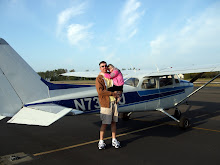
1.3hrs – Power on stalls, steep turns, emergency landing procedures, pattern work, mental blocks overcome.
So far at Twin Oaks I’ve just not been able to take off and climb out cleanly. Either I’d veer one way then the next, lift off uncoordinated, try pulling it off too soon, or you name it. Finally, I was able to take off from Twin Oaks without any unnecessary excitement. Right off, a big mental block out of the way.
We reviewed power off stalls, which we had done in lesson 5, then proceeded to power on stalls. My CFI demonstrated a few, then, knowing that I’m still a little uneasy at times, asked how I was doing. I thought “Hey, I’m actually fine with this, and feeling pretty comfortable”. I practiced several, and found them to be quite fun to do, but dropped the right wing in all. I’m continuing to hold too much right rudder during the stall break. My CFI also demonstrated what happens with no rudder and other errors. Another mental block out of the way.
Next was what to do when the engine fails. My instructor demonstrated by pulling the throttle all the way back to idle. A Cessna 172 glides better than you may think (somewhere about a 10:1 ratio, so 10 feet forward per 1 foot drop in altitude at best glide speed). Once we had our chosen field made, we climbed back out. My turn. I was able to choose a suitable field (not hard over Willamette valley farm land), stay pretty close to best glide, etc, and get to a point where we had the field made. As we’re climbing out and passing about 1500ft, my CFI asks if I feel I understand the process. I answer yes, and he immediately pulls the throttle (should of seen that coming). Again all goes pretty smoothly but could use some work.
Steep turns (45 degree bank angle) were the next item on the agenda. These are a little tricky, because some of your vertical lift is lost due to the bank, and becomes horizontal lift, so you need to add some back pressure, as well as little throttle, while staying coordinated with the rudder, and controlling the bank angle with the ailerons. I had trouble with maintaining altitude, especially while in a steep turn to the right, but I felt comfortable with the process, and just need to practice.
Back to Twin Oaks for Pattern work. My CFI demonstrated the first landing. I taxi and take off, again without any unnecessary excitement (two in a row - sweet!). My first pattern was not so good, and really began to fall apart on short final. We were coming in fast and floating past a good portion of runway, when my CFI says “go around right now”. I’ve read about go-arounds, but this was the first time I’d heard this first hand. I began climbing, but the nose pitched high and we began losing airspeed, corrected for that but coordination suffered, and so on (I know something I need to spend a little more time on next lesson). I was wound pretty tight by the time we got back in the pattern, but really focused on relaxing, and what my next step is. This time around was much better. I was hitting all my air speeds, relaxed, made good turns, worked through how narrow Twin Oaks appears on final, and with a little coaching in the flare, touched down nice and easy. I even managed a straight roll out. Another block overcome.
So in the end a great lesson! Everything needs more work, but I got home and thought “Wow, I can fly an airplane smoothly off the ground, and climb out. Someday I will be a pilot”. How cool is that.....
Good Stuff!!







